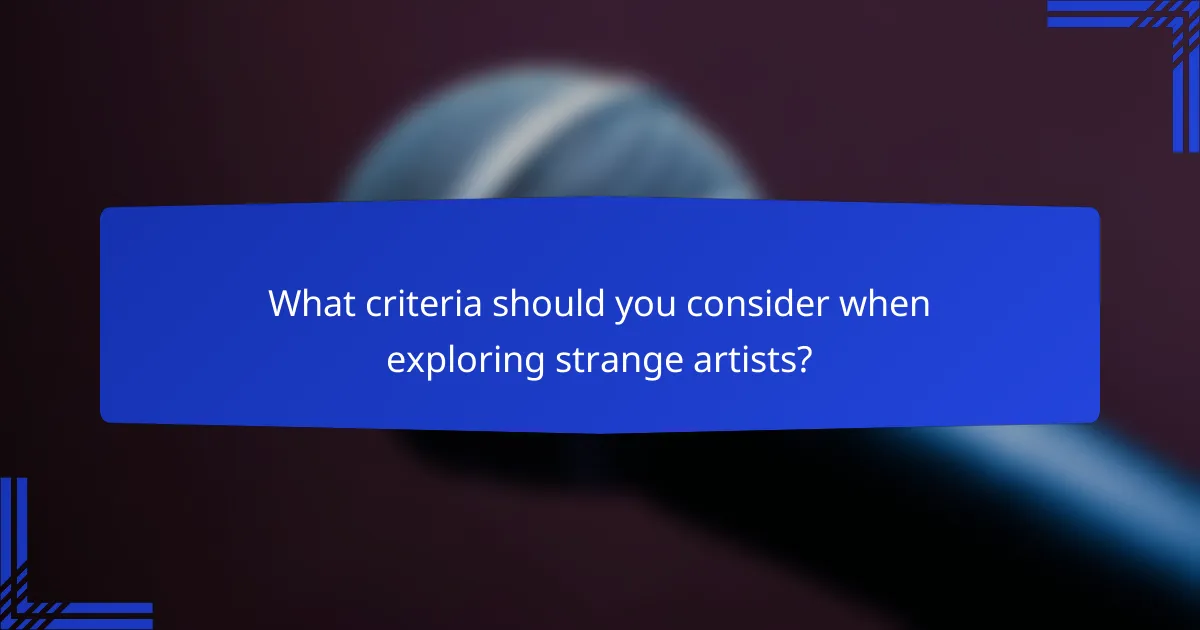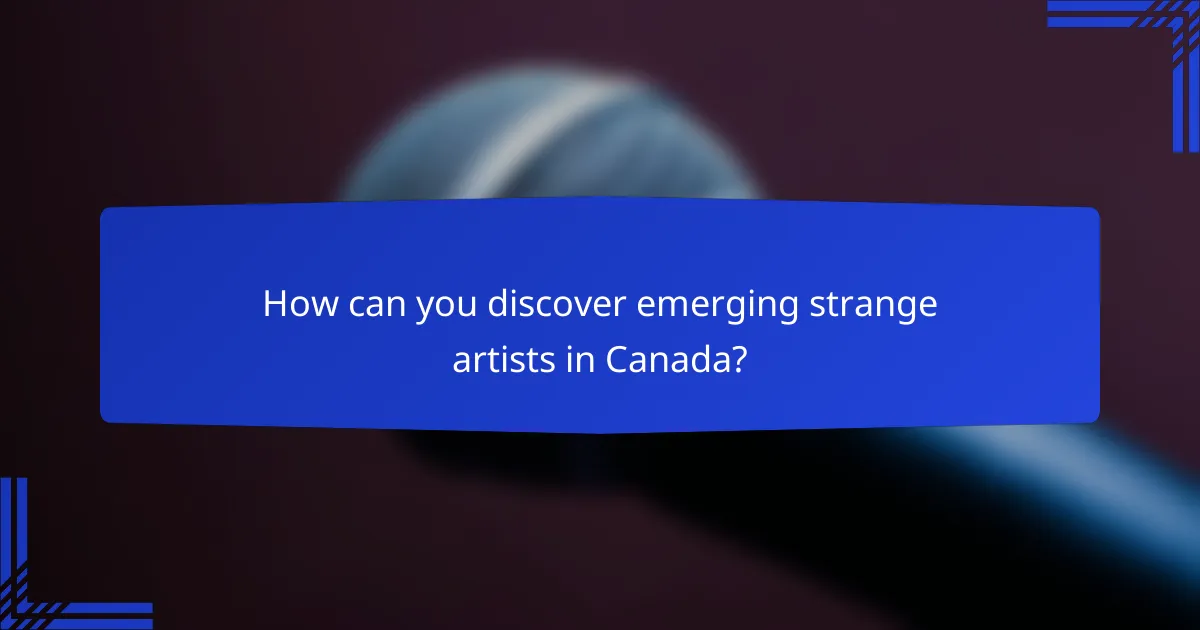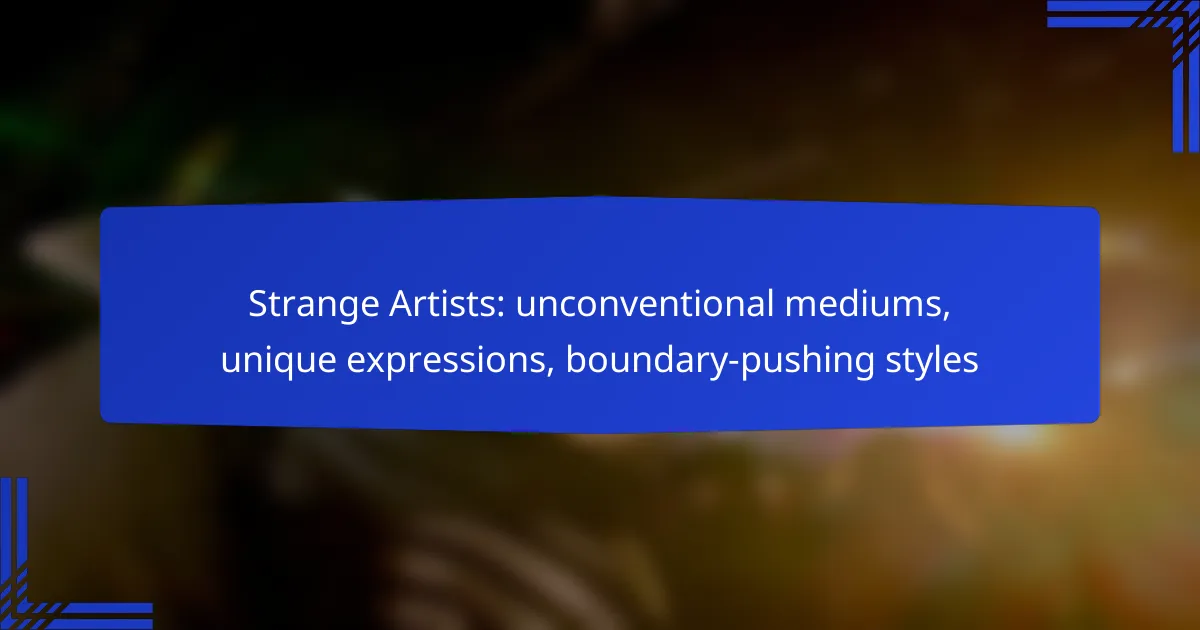Strange artists are redefining the landscape of contemporary art by embracing unconventional mediums and innovative techniques. From mixed media installations to performance art, these creators challenge traditional boundaries and express their ideas in unique ways. Their boundary-pushing styles, including surrealism and conceptual art, invite viewers to engage with thought-provoking works that reflect diverse perspectives and emotions.

What are the unconventional mediums used by strange artists in Canada?
Strange artists in Canada often utilize unconventional mediums that challenge traditional art forms. These mediums include mixed media installations, found object sculptures, digital art created with unique tools, performance art, and street art, each pushing the boundaries of creativity and expression.
Mixed media installations
Mixed media installations combine various artistic elements, such as painting, sculpture, and video, to create immersive experiences. Canadian artists often incorporate local materials and themes, allowing viewers to engage with the work on multiple sensory levels. For instance, an installation might blend textiles, sound, and video projections to explore cultural narratives.
When creating mixed media installations, consider the spatial arrangement and how each component interacts with others. This approach can evoke emotions and provoke thought, making the experience more impactful.
Found object sculptures
Found object sculptures utilize everyday items repurposed into art, challenging perceptions of value and creativity. Canadian artists frequently source materials from their surroundings, such as discarded furniture or industrial waste, to create thought-provoking pieces. This method not only promotes sustainability but also encourages viewers to reconsider the potential of ordinary objects.
To create effective found object sculptures, focus on the narrative behind the materials. Each piece should tell a story or convey a message, inviting viewers to reflect on their relationship with the objects and the environment.
Digital art with unconventional tools
Digital art created with unconventional tools involves using non-traditional software or hardware to produce artwork. Canadian artists may employ everything from coding to 3D printing, often blurring the lines between art and technology. This medium allows for innovative expressions, such as interactive installations or generative art that evolves over time.
When experimenting with digital tools, be open to exploring various platforms and techniques. This flexibility can lead to unique outcomes and broaden your artistic vocabulary, enhancing your overall creative practice.
Performance art
Performance art is a live art form that combines visual art with theatrical elements, often focusing on the artist’s body as the medium. Canadian performance artists frequently address social issues, identity, and cultural heritage, creating powerful statements that resonate with audiences. This form allows for immediate interaction and emotional engagement.
To succeed in performance art, consider the context and setting of your piece. Engaging with the audience and creating a dialogue can significantly enhance the impact of your performance.
Street art and graffiti
Street art and graffiti transform public spaces into canvases, often conveying political messages or social commentary. In Canada, artists use these mediums to challenge norms and beautify urban environments, making art accessible to a broader audience. This form of expression can range from intricate murals to simple tags, each with its own cultural significance.
When creating street art, be mindful of local regulations and community sentiments. Understanding the environment and audience can help ensure your work resonates and contributes positively to the space.

How do unique expressions manifest in contemporary art?
Unique expressions in contemporary art often emerge through unconventional mediums and innovative techniques that challenge traditional boundaries. Artists utilize a variety of methods to convey their ideas, emotions, and critiques, resulting in diverse and thought-provoking works.
Emotional abstraction
Emotional abstraction focuses on conveying feelings rather than depicting recognizable subjects. Artists often use color, form, and texture to evoke specific emotions, allowing viewers to interpret the artwork based on their personal experiences. This approach can lead to a deeply subjective interaction between the artwork and the audience.
For instance, abstract expressionists like Mark Rothko used large swathes of color to create an emotional response, encouraging viewers to engage with their feelings rather than the visual representation. This style can vary widely, with some artists opting for vibrant palettes while others may choose muted tones to reflect different emotional states.
Social commentary through satire
Satirical art serves as a powerful tool for social commentary, using humor and irony to critique societal norms and issues. Artists often exaggerate or distort reality to highlight flaws in politics, culture, or human behavior, prompting viewers to reflect on these subjects critically.
An example is the work of Banksy, who employs street art to address topics like consumerism and war. His pieces often provoke discussion and debate, making them not only visually striking but also socially relevant. This method can be particularly effective in engaging a wide audience, as humor tends to resonate across various demographics.
Interactive audience engagement
Interactive audience engagement transforms the viewer from a passive observer into an active participant in the artwork. This approach invites individuals to influence the piece through their actions, thoughts, or emotions, creating a dynamic relationship between the art and its audience.
Examples include installations that require audience participation, such as those by artist Olafur Eliasson, where viewers physically interact with elements of the artwork. This engagement can deepen the viewer’s connection to the piece and enhance their overall experience, making the art more memorable and impactful.

Which boundary-pushing styles are prominent among Canadian artists?
Canadian artists are increasingly known for their boundary-pushing styles that challenge traditional norms and explore unconventional mediums. Prominent styles include surrealism, postmodern deconstruction, and conceptual art, each offering unique expressions and innovative approaches to creativity.
Surrealism in modern contexts
Surrealism in modern Canadian art often blends dream-like imagery with contemporary themes, creating a unique narrative that resonates with current societal issues. Artists utilize unexpected juxtapositions and bizarre scenarios to provoke thought and evoke emotions, making the viewer question reality.
For example, works may incorporate digital manipulation alongside traditional painting techniques, allowing for a fusion of styles that enhances the surreal experience. This approach not only captivates audiences but also encourages them to explore deeper meanings behind the artwork.
Postmodern deconstruction
Postmodern deconstruction in Canadian art focuses on dismantling established narratives and questioning the very nature of art itself. Artists often employ irony, parody, and pastiche to challenge viewers’ perceptions and highlight the complexities of identity and culture.
Common techniques include the use of mixed media and installation art, where everyday objects are recontextualized to convey new meanings. This style invites audiences to engage critically with the artwork, prompting discussions about authenticity and representation in contemporary society.
Conceptual art
Conceptual art emphasizes the idea behind the artwork over its aesthetic value, making the concept itself the primary focus. Canadian artists in this genre often create works that provoke thought and discussion, using text, performance, and interactive elements to engage viewers.
For instance, installations may incorporate social commentary or address political issues, encouraging audiences to reflect on their own experiences and beliefs. This approach not only challenges traditional artistic boundaries but also fosters a deeper connection between the artist and the audience, making the art experience more participatory.

What criteria should you consider when exploring strange artists?
When exploring strange artists, consider their artistic intent, the mediums and techniques they use, and how audiences engage with their work. These factors help you understand the unique expressions and boundary-pushing styles that define unconventional art.
Artistic intent and message
Artistic intent refers to the purpose behind a piece of art and the message the artist aims to convey. Strange artists often challenge societal norms or provoke thought through unconventional themes, which can range from political commentary to personal narratives. Understanding this intent can deepen your appreciation of their work.
For example, an artist using recycled materials might aim to highlight environmental issues, while another might explore identity through abstract forms. Recognizing these intentions allows viewers to connect more meaningfully with the artwork.
Medium and technique
The choice of medium and technique is crucial in defining the uniqueness of strange artists. Many utilize unconventional materials such as found objects, digital media, or even biological elements, pushing the boundaries of traditional art forms. This experimentation can lead to innovative expressions that challenge viewers’ perceptions.
When evaluating an artist’s work, consider how their chosen medium enhances or alters the message. For instance, an artist who uses light installations may create an immersive experience that engages viewers in a different way than a traditional painting would.
Audience reception and engagement
Audience reception plays a significant role in the impact of strange artists. How viewers respond to unconventional art can vary widely, from admiration to confusion. Engaging with the audience often involves interactive elements or thought-provoking installations that invite participation.
To gauge audience engagement, look for feedback through social media, gallery discussions, or art critiques. Understanding how different demographics react can provide insights into the broader cultural significance of the work. Additionally, consider attending exhibitions or events where strange artists showcase their work to experience the engagement firsthand.

How can you discover emerging strange artists in Canada?
To discover emerging strange artists in Canada, explore local art galleries, online platforms, and social media. Engaging with art communities and attending exhibitions can also help you find unique expressions and unconventional mediums.
Explore Local Art Galleries
Local art galleries often showcase the work of emerging artists, including those with unconventional styles. Look for galleries that focus on contemporary or experimental art, as they are more likely to feature boundary-pushing creators. Regular visits to these spaces can help you stay updated on new talent.
Consider attending opening receptions or artist talks, which provide opportunities to meet the artists and learn about their creative processes. Many galleries also host special events or exhibitions that highlight strange artists, making them a valuable resource.
Utilize Online Platforms
Online platforms like Instagram, Behance, and Etsy are excellent for discovering strange artists. Search for hashtags related to unconventional art, such as #strangeart or #experimentalartists, to find unique works. Following art curators and influencers can also lead you to emerging talent.
Many artists share their work and creative journeys online, allowing you to engage with them directly. Keep an eye on online art fairs and virtual exhibitions, which often feature innovative artists from across Canada.
Engage with Art Communities
Joining local art communities or online forums can enhance your discovery of strange artists. Participate in discussions, attend workshops, and connect with other art enthusiasts to share recommendations and insights. Local art collectives often host events that spotlight unconventional artists.
Networking within these communities can lead to collaborations and deeper insights into the art scene. Look for community events, such as pop-up galleries or artist markets, to experience a variety of unique expressions firsthand.
